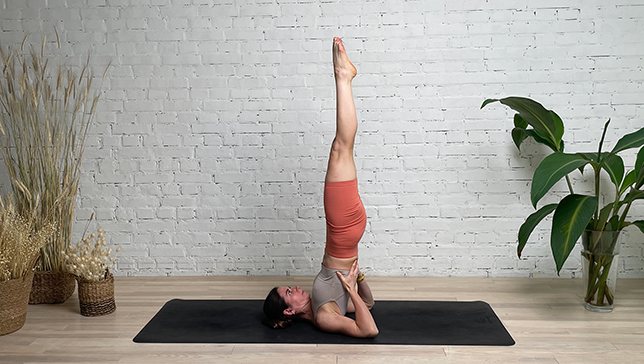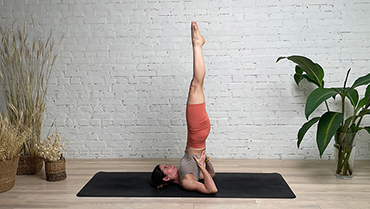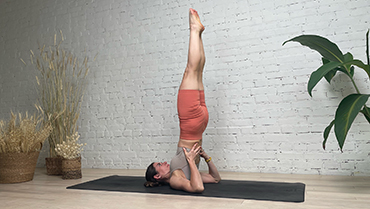Shoulderstand Pose - Salamba Sarvangasana

Contents
Shoulderstand Pose or Salamba Sarvangasana in Sanskrit (salamba, meaning “supported,” sarva, meaning “all,” anga meaning “limb,” and asana, meaning “pose” or “posture.”). This translates to ‘All Body Parts Pose’. Salamba Sarvangasana is also known as the “Mother of all Yoga Poses” because it benefits the entire body and also the mind. Shoulderstand Pose (Sarvangasana) can be categorized under intermediate-level yoga poses. To practice this asana, yoga practitioners should have some level of comfort with various intermediate-level yoga poses. As the entire body is balanced on the upper shoulders this pose is also called ‘Kandrasana’ or ‘Shoulderstand Pose’.
Sarvangasana is considered a base pose as Sarvangasana variations can be derived from this pose. Sarvangasana helps calm the mind and turn on the parasympathetic system, hence can be included at the end of yoga sequences.
Pose Detail
- By Type: Balancing Yoga Poses
- Difficulty: Intermediate
- Body Position: Inversion Yoga Poses
- By Benefit: Yoga Poses For Anxiety And Panic Attack, Yoga Poses For Digestion, Yoga Poses For Sleep, Yoga Poses For Stress Relief
Step-by-Step Instructions
Benefits and Contraindications
Strengthens your shoulder and neck muscles.
Helps open your shoulders.
Strengthens your legs.
Builds strength in core and the whole torso.
Calms nerves
Reduces anxiety, insomnia, and irritability
Aids digestive disorders
Increases circulation to the brain
Boosts the immune system
High blood pressure
Menstruation
Glaucoma
Pregnancy
Back pain or spine injury
Spondylitis
Certain heart problems (consult your doctor)
Throat or ear infection (this pose might cause discomfort)
Detached retina
Photo poses in different angles


Modifications and Props For Beginners
- Blankets: Placing blankets under the shoulders, neck, and head can help provide support and cushioning, making the pose more comfortable. Folded blankets can also be placed under the elbows to help lift the shoulders away from the ears.
- Blocks: Blocks can be placed under the hips to elevate them, making it easier to get into the pose. They can also be used to provide additional support and stability.
- Straps: Straps can be used to keep the arms and shoulders in place, preventing them from sliding or moving during the pose. They can also be used to provide additional support and stability.
- Wall: Practicing Salamba Sarvangasana with the feet against the wall can help provide support and stability, making it easier to hold the pose for longer periods. It can also help prevent the body from tipping over.
- Shoulderstand bench: A shoulderstand bench can provide additional support and make it easier to get into the pose. The bench allows the shoulders and head to rest on a platform, providing more stability and reducing the risk of neck strain.
Useful Tips
- When you are practising Shoulderstand don’t be afraid of using lots of props to raise your shoulders and upper back. The most important thing in Shoulderstand is to take care of your neck.
- Keep the neck straight and avoid turning the head. The weight should be distributed evenly between the shoulders and elbows, and the feet should be stacked directly above the hips.
- You can bring your legs to a 45 degree angle instead of pointing them upwards to the ceiling.
- Be aware of the position of your elbows – roll your upper arms outwards to prevent your elbows from splaying out to the sides.
- Keep your core engaged to help lift your hip and allow your hands to walk further up your back for support.
- Focus on deep, slow, and rhythmic breathing during the pose. Breathe through the nose and keep the breaths even and steady.
- Hold the pose for as long as it feels comfortable, starting with a few seconds and gradually increasing the duration. Avoid holding the pose for too long, especially if you’re a beginner.
- When releasing the pose, come down slowly, one vertebra at a time, and avoid jerky movements. Use your hands to support your back as you come down.
Variations
- One-Legged Shoulder Stand
- Side Shoulder Stand
- Supported Shoulderstand Pose Chair Variation Bound Angle Legs
- One Legged Shoulderstand Pose Hands On Back
- Shoulderstand Pose With Blanket And Strap
- Shoulderstand Pose Bent Legs
- Upward Lotus Pose
- One-Legged Shoulderstand Pose
- Shoulderstand Pose Wide Legs
- Unsupported Shoulderstand Pose Variation